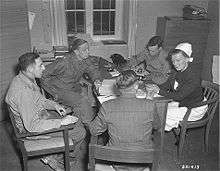Irmgard Huber

Irmgard Huber (1901–1983)[1][2] was the head nurse of Germany's Hadamar Clinic, a psychiatric facility. Beginning in late 1939, it was operated as one of six major centers for Action T4, a secret sterilization and euthanasia program in Nazi Germany. Nearly 15,000 German citizens were killed here, including thousands of children.
After the war and the defeat of Germany, in 1945 this area was within the American Zone of Occupation. Huber was prosecuted and convicted by the United States military for murders of forced laborers from Poland and other allied countries, and sentenced to 25 years in prison. In 1946, she was prosecuted and convicted by newly reconstructed German courts for the murders of German citizens. Her sentence was lengthened by eight years.
Early life and career
Irmgard Huber was born and grew up in Hadamar. She went to local schools and to nursing school, entering the profession in 1932. Before the end of that decade, she had become head nurse at Hadamar Clinic, a major psychiatric facility.[2]
Background
At the close of World War II, when American forces occupied the small German town of Hadamar, they heard rumors about the murder of the mentally ill patients at a local psychiatric hospital. Allied prisoners of war held in the area reported having seen black smoke coming from the facility's chimney.
They learned that Hadamar was one of six major "euthanasia" facilities in Nazi Germany that killed thousands of Germans deemed to have incurable illness; most had physical and mental disabilities. Hitler determined that he did not want to use state funds to maintain them in wartime and that they should have "mercy deaths". Death certificates were falsified.
After German unification in 1990, new records were found that enabled historians to establish that a total of 200,000 Germans were killed nationally in this programme. At Hadamar, nearly 15,000 mentally or physically disabled people: children first and then adults, were killed, first the patients of the facility, then others bussed in from such institutions as nursing homes, old age homes, and state childcare institutions.
The Americans wanted to prosecute the murders, but were limited by international law to crimes against their own military personnel, or military or civilians of allies. Hospital records revealed that 476 forced laborers from Poland and the Soviet Union—Allied countries—had also died at Hadamar. Their murders were within American jurisdiction.
Irmgard Huber, head nurse of the hospital, was among the staff members who were arrested by the Americans. Her claims that she never killed patients were corroborated by co-workers and witnesses. She was released.
Later, the court ruled that Huber had played a role in selecting patients for murder and in falsifying death certificates. She also controlled the supply of drugs used to lethally overdose patients, the preferred method of "euthanasia" from 1941 through 1945. Huber was rearrested, tried with six others and convicted. Leon Jaworski, prominent later in the United States during the Watergate hearings, was the chief prosecuting official. Huber was sentenced to 25 years in prison for serving as an accomplice to murder.
As the only female defendant, she received the lightest sentence at the trial. Chief administrator, Alfons Klein, and two male nurses, Heinrich Ruoff and Karl Willig, were sentenced to death. The chief physician, Adolf Wahlmann, received a life sentence (commuted because of his ill health). Two other members of the administrative staff received sentences of 20 to 35 years.
In 1946, after reconstruction of German courts under the occupation, Huber was among twenty-five members of the Hadamar staff, including Dr. Wahlmann, tried for murders of thousands of German citizens at Hadamar. Convicted as an accomplice to murder in at least 120 cases, Huber was sentenced to eight additional years in prison. Dr. Wahlmann was also convicted in the second trial, and sentenced to death. This was commuted to imprisonment because he was in ill health.
Later life
Irmgard Huber was released from prison in 1952, in actions the US took during the Cold War because of political pressures. She lived in Hadamar until her death there in 1983.[2]
Notes and references
- ↑ Sandner, Peter (2003). "Biographische Daten" (PDF). Verwaltung des Krankenmordes: Der Bezirksverband Nassau im Nationalsozialismus (pdf). Historische Schriftenreihe des Landeswohlfahrtsverbandes Hessen Hochschulschriften (in German). p. 731. Retrieved 2010-04-11.
- 1 2 3 Laytner, Ron (1984-01-12). "Hadamar town of mass murderers". The Deseret News (Salt Lake City). p. 25. Retrieved 2010-04-11.
This article incorporates text from the United States Holocaust Memorial Museum, released under the GFDL.
External links
- United States Holocaust Memorial Museum – Irmgard Huber